John Morrison Batchelder Jr. is not going to friend you on Facebook. He isn’t going to like your posts or watch your latest YouTube video. He isn’t going to answer your calls when he’s on the road. If curiosity strikes, Google is the last place he will look to educate himself, and he sure as hell won’t be buying anything on Amazon or eBay any time soon. He doesn’t own a cell phone or a computer. The credit card companies don’t even know his name.
He is, however, a walking encyclopedia of knowledge and history pertaining to Indian motorcycles and vintage racing. And if you are lucky enough to spend any amount of time with him, it becomes very clear that a lifetime of connectivity means nothing compared to a lifetime of living.
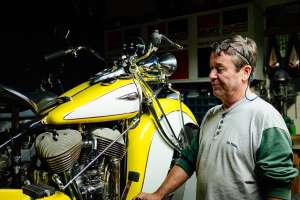
Twelve years ago, a freak construction accident should have killed John Morrison Batchelder Jr. Instead, it robbed him of the ability to ride. Then, one year ago, a negligent driver on an ATV nearly took away his ability to walk. But Duffy, as his friends call him, is alive, well, and living out his passion: museum-worthy Indian motorcycle restorations. Tucked away in rural New Hampshire, his words tell us hundreds of stories about the heyday of racing and riding in New Hampshire. His eyes tell a thousand more with every blink. The man has seen a lot.
We didn’t find Duffy through the internet, or even by word of mouth from our circle of friends. No, Duffy found us. Rather, he appeared one summer afternoon as if he materialized out of the ether. A casual conversation with a friend who had stopped by to show us his latest vintage build was politely interrupted when a quiet voice from behind us chimed in. “Are you racing that bike this weekend?” None of us even realized he had sidled up from behind to admire the machine that we were huddled around. He was unassuming, and I’ll admit shamefully that we half-heartedly humored him at first glance, answering questions but not offering a proper reception.
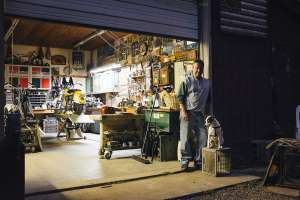
His tenacity was evident, and had it not been, he would have gone on walking, probably unlikely to appear again. Instead, he went to his truck and carried back some photos to show us, proudly displaying his shop full of Indian motorcycle restorations, watching our eyes widen at the sight of his craft. Through this, we learned a hard lesson about first impressions. In the weeks that followed the fateful meeting, Duffy visited our shop several times. And his stories of youth-ful hooliganism, riding motorcycles, shooting guns, and the heroes of a racing era gone by always left us better than before he’d arrived.
Every great story has a hook, but this one didn’t catch us until later that summer. Duffy arrived on a late Friday afternoon, prompting us to come outside to see his latest creation. A quick glance out the window revealed Duffy’s mid-1980s blue Toyota pickup hauling cargo of a special kind: a perfect recreation of Ed “Iron Man” Kretz’s 1937 Indian Sport Scout. It was like staring back in time. This machine dominated the race circuit of the late 1930s. Duffy had set out to recreate the bike based on a photo hanging in his shop. With the deep blue Indian that sat before us, he had succeeded in every way. Kretz was legendary, and this bike radiated a history of domination. As an excerpt from a vintage copy of “Cycle World” magazine Duffy gave us says:
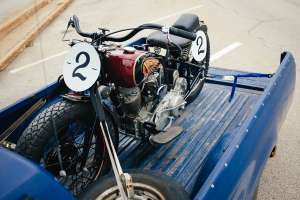
“The crowd rose, cheering wildly as the husky man on the roaring Indian Scout loomed out of the shadows and came down the straightaway toward the finish line. This was Ed Kretz Sr., winning the National Championships 200-miler at Laconia, N.H., in 1938, after a wild, grueling 4.5-hour ride that earned him the nickname of ‘Iron Man.’ Nearly everything had happened to Kretz that day. He had fallen off, fouled his carburetor, spent 15 minutes in the pits, lost his left footboard after 50 miles and been forced to ride the rest of the route holding his left steel boot atop his primary drive case. To keep his machine upright, he had gripped the bars so tightly he had worn three layers of skin off his blistered hands. At the finish, the timekeeper glanced at his watch. ‘I’ll be damned,’ he said. ‘Kretz turned the last lap faster than the first.’”
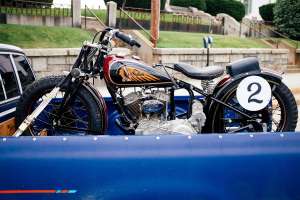
Like the chains that held the mighty Kong, the tie-downs in the bed of the pickup seemed the only thing restraining the Sport Scout from tearing the Toyota right in half. I ran my fingers along the tread of the tires, pulling a stone from between the deep grooves, knowing what this machine was capable of if unleashed on the dirt track in the iron grip of Kretz. Like a proud father, Duffy beamed, baiting us with anticipation of hearing it run. “She runs great. I’ll start it up for you.” Before the words “Yes, please” could come out, he was up in the bed of the pickup, kicking the bike over. One, two, three kicks and it started with a growl, breathing, igniting, and exhaling a beautiful, rough arrogance like a late-night Tom Waits number.
Proud as he was, Duffy was handing the Scout over to someone who would have even more of a sentimental attachment to it: Ed Kretz Jr. Duffy explained that he contacted Jr. when he was doing research for the build. “I was calling him for some photographs. We were working back and forth and after a few months, he asked me ‘What are you doing with this thing?’ and I told him my intentions were to probably sell it. So he said, ‘I want it!’ and it was as simple as that.”
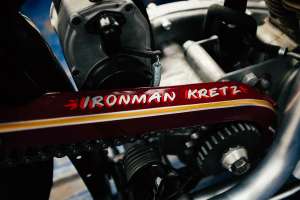
Ten days after Ed Kretz Jr. took delivery of the fabled Scout, he took it for a Sunday ride and suffered a heart attack along his route, dying while doing what he loved. He was 81. The date was Sept. 8, 2013, nearly 75 years from the day his father won the 200-mile race in Laconia. Duffy was devastated, and a phone call from him with the news was as haunting as it was bittersweet. Ed Kretz Jr. died on a machine that connected him to his late father. Moments like these force you to slow down and reflect on the speed of your daily life. It was time to disconnect, and we knew we had to pay Duffy a visit.
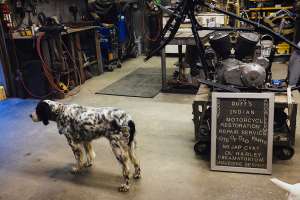
Several miles off the highway, through a winding, his- toric, 300-year-old town, down at the end of a dirt road and outside the region of any possible cellular signal, we’re standing outside Duffy’s home, staring at a chimney where he and his lifelong friend, Robby Dubuque, have been applying a vinyl facade. “Vinyl is final,” he reluctantly laughs, apologetically poking fun that “It’s a cheap house.” But it’s more of a simple living than a cheap one; the place is more of a home than many people can claim of their own domiciles. Despite his wisecracks, it is a place he is proud of, and that’s clear when he shows the work that has been done inside. Thirty years ago, this house belonged to a Boston mobster. It was a getaway of sorts in the backwoods of New Hampshire that had two phone lines coming in and out and a completely pink room reserved for guests of a special sort. With the exception of the latter, the home still serves the same purpose to Duffy as it did to its former owner; it offers seclusion from unwanted passersby yet is close enough to reach civilization when necessary–something Duffy could go with or without on any given day.
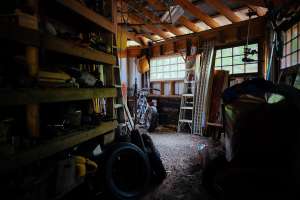
His workshop is down the hill, the sheer size of it forcing a double take to compare which is larger, the house or the giant red barn full of projects. Indians are carefully placed around the shop, all in various states of repair or restoration, each one telling a story uniquely their own, including a bright yellow 1940 Indian Chief getting a generator, and a frame-up restoration of an extremely rare four-cylinder 1928 Indian Ace. Duffy knows these bikes like they are old friends, and he compassionately explains the intricacies of each one, from character flaws like a twisted fork on a ‘34 Indian Chief to the uniqueness and rarity of the single down-tube frame in the Indian Ace, which was only produced for six months after Indian bought out the Ace Motor Company in 1927.
Duffy doesn’t ride motorcycles anymore, and it is incomprehensible to understand how that is possible, like learning that Colonel Sanders was a vegan. In his early years, a Harley was the gateway to Duffy’s passion for Indians. Well, crashing a Harley anyway. “I crashed a Harley and bought an Indian Scout cheap and I fell in love.” That love is evident in every word he speaks. “I’ve ridden more goddamned motorcycles to last a lifetime.” We pore through a half-dozen photo albums he has carefully placed in various locations around the shop. Every photo has a story, every person is an essential piece of who he is, and every motorcycle he has made his mark on resides in his memory and in the laminated pages of these albums. There is a crack of a smile when he looks at each bike.
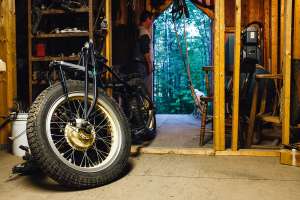
A slightly bashful school boy crush of emotion washes over him, and I imagine that the time he is privileged to spend with these bikes is like falling in love each and every day. Only when he brings up his wife and daughters does that same look come over him. He is a family man at his core, gushing over his children and grandchildren, a family he worked over 20 years as a truck and train scale mechanic to provide for. While working, he suffered a brutal accident when an industrial washing machine fell off a tractor-trailer and landed on him. “I got angry as hell and ran around trying to pop my shoulder back into its socket. My buddy said I looked like a monkey trying to fuck a football. I ended up driving myself to the hospital.” Because of that, workers’ comp was out of the question, and the multiple injuries from the incident left him with permanent damage that made riding more painful than he could bear.
“I don’t miss riding. I like working on bikes. I don’t really care to ride anymore. I’ve had my fill. It’s pretty enjoyable to see somebody enjoying something I’ve put together. As far as I’m concerned, there’s life after death. Everyone looks at these and they just see something creepy, like a big old…” Duffy’s pose approaches rigor mortis, and he motions to the skeleton of the ‘28 Indian Ace frame before us. “And I tell them I’m gonna build a motorcycle out of that.”
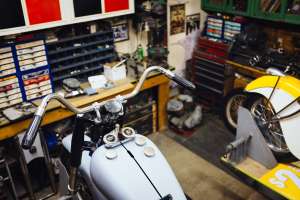
His restorations reside in several museums, including the American Police Motorcycle Museum and the Americana Museum, both in New Hampshire. Scanning the shop, it is appropriately museum-like in its order and cleanliness. Everything is neatly organized and every object tells a story. I hone in on a small gauge tucked away between some drawers of nuts and bolts, and from across the room, Duffy beams that “there’s a great story behind that gauge, or maybe not so great.” The cracked glass and malformed housing are the result of a perfect gauge being crushed in a scrap yard before it could be rescued.
Every inch of this garage tells stories like this. Tiny moments of time captured by inanimate objects, whose collector speaks on their behalf, giving them life and personality. The space is living and breathing, with an energy that comes from a passion for bringing dead things to life. There are several bikes in front of us, but when we ask how many he is actually working on, Duffy laughs and begins to point at every frame, tank, and wheel in sight. “One, two, three, four, five, six, seven…” he chuckles with a subtlety of truth in his laughter.
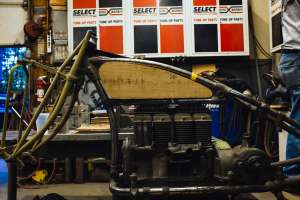
Because he no longer rides, he has something else to fill the void. He moves through the shop with the excitement of a kid on Christmas, and a slight limp in his step becomes more noticeable as we move at a quickened pace to the back of the garage. A year ago, there was an incident on his road that prompted him to run after a reckless ATV rider driving past his home. The driver came at him with the machine and the foot peg struck him, shattering his lower leg and leaving him nearly unable to walk. “We got him. He’s paying for what he did.”
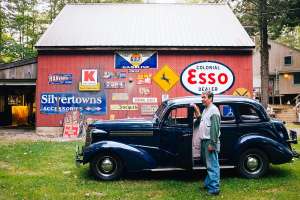
Around the corner, the ‘38 Chevy Master sits quietly in a covered garage behind his shop. It looks like something out of a mobster movie, and it is meticulously maintained, as are his motorcycles. The rounded yet muscular lines and deep blue paint seem strangely familiar, and images of Ed Kretz’s Sport Scout flash in my mind. Kretz’s bike always donned the number 38, but the correlation is perhaps more coincidental than kismet. Proudly, it is driven daily, and again, his humility comes through when he explains that it was a budget model back in its time. “Nothing fancy. It didn’t even come with an armrest. That cost extra.”
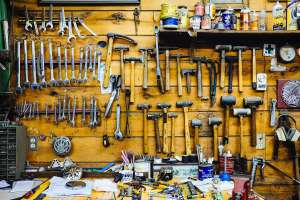
Several hours go by with Duffy in what seems like minutes, and I’ve completely lost track of time. Glancing at my phone, I notice there is still no signal, and it feels freeing, like I’ve stepped off the civilized reservation and into a timeless place. Here, the lack of distractions and constant desire for contact and communication lead to creating something more visceral and meaningful to the rest of the world. Once again, I am parting ways with Duffy a better person than I was before. Tuning out the distractions and discarding the rotting layers of decay reveals what is beautiful underneath, and through this, there is new life to be found.
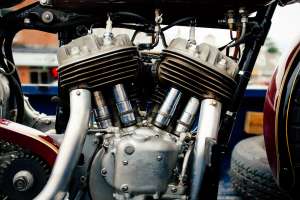
This article first appeared in issue 11 of Iron & Air Magazine, and is reproduced here under license
Story and Images by Adam Fitzgerald